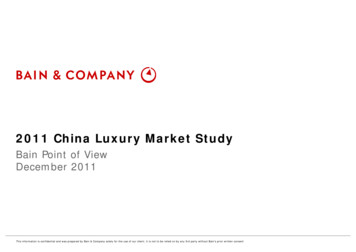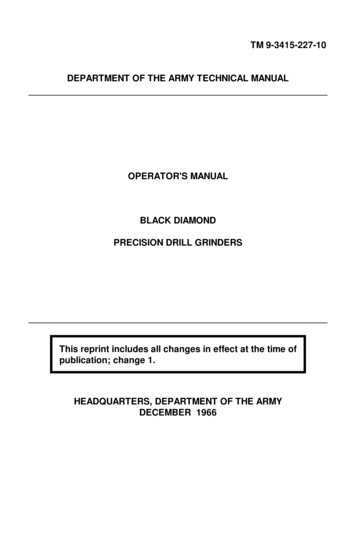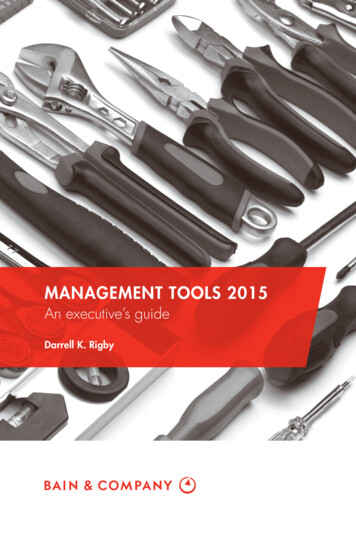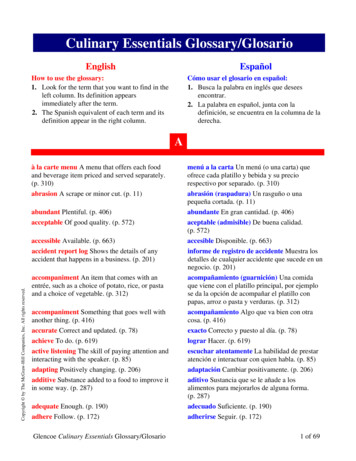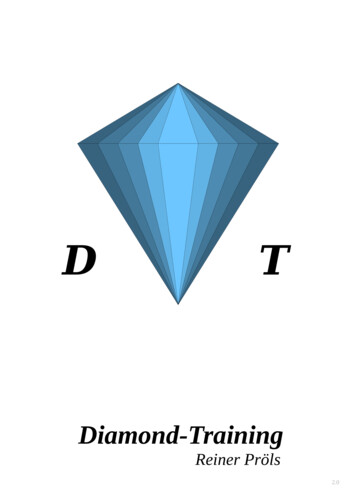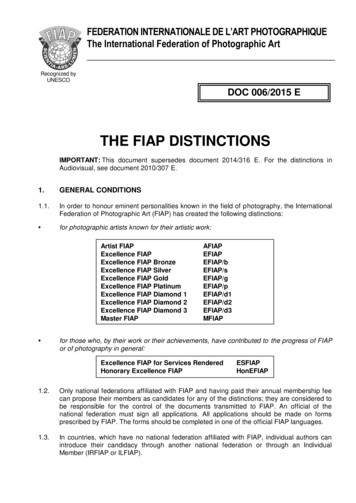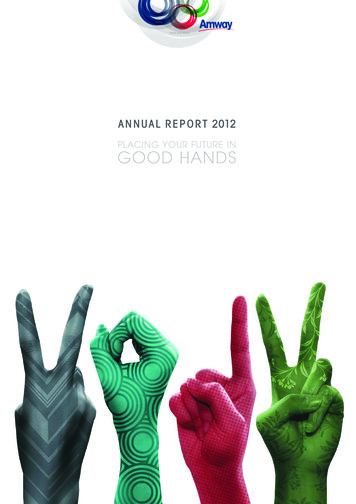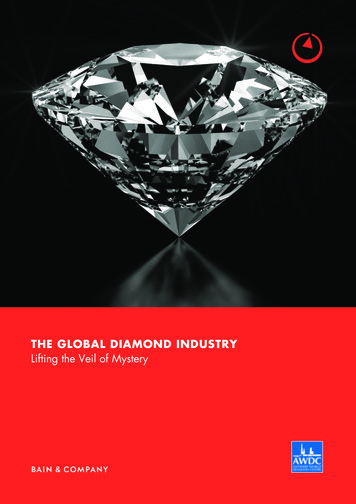
Transcription
THE GLOBAL DIAMOND INDUSTRYLifting the Veil of Mystery
This work was commissioned by AWDC and prepared by Bain. This work is based on secondary market research, analysis of financial information available or provided to Bain & Company and AWDC, and a range of interviews with customers, competitors and industry experts. Bain &Company and AWDC have not independently verified this information and make no representation or warranty, express or implied, that suchinformation is accurate or complete. Projected market and financial information, analyses and conclusions contained herein are based (unlesssourced otherwise) on the information described above and on Bain & Company’s and AWDC’s judgment, and should not be construed asdefinitive forecasts or guarantees of future performance or results. Neither Bain & Company nor AWDC nor any of their subsidiaries or their respective officers, directors, shareholders, employees or agents accept any responsibility or liability with respect to this document. This documentis copyright Bain & Company, Inc. and AWDC and may not be published, copied or duplicated, in whole or in part, without the written permission of Bain and AWDC.Copyright 2011 Bain & Company, Inc. and Antwerp World Diamond Centre private foundation (AWDC) All rights reserved
Diamond Industry Report 2011 Bain & Company, Inc.ContentsNote to readers.11.Introduction to diamonds.3What is a diamond? Super hard and luminescent.3Origins: deep within the earth.3Uses of diamonds: jewels and industrial tools.5Key takeaways.62.Historical transformation of the diamond industry.7Early history: how it all started.7Creation of demand through marketing: “A diamond is forever”.8Diversification of diamond supply: expansion across four continents.8Expansion of rough-diamond sales channels.11Impact of the De Beers transformation on the industry.12Kimberley Process: a solution for conflict diamonds.15Key takeaways.173.The diamond industry value chain.19A diamond value chain overview: a journey “from mine to finger”.19Value chain economics.22Exploration: long times, great uncertainty.22Production: mining mechanics, leaders and profitability.28Sorting rough diamonds into categories for valuation.38Rough-diamond sales: three ways to sell rough.39The Antwerp connection.41
Diamond Industry Report 2011 Bain & Company, Inc.Rough-diamond pricing: supply and level of dealer speculation are key drivers.42Cutting and polishing: the shift to Asia.42Polished-diamond pricing: consumer demand is the key driver.45Polished-diamond sales.46Jewelry manufacturing and retail: a fragmented landscape.48Diamond industry financing.52Key takeaways.544.Demand for diamonds in the global economy.55Key sources of diamond demand: jewelry and industrial applications.55Gem-quality-diamond demand: a tight link to luxury goods and jewelry markets.55Market dynamics of luxury goods.55Jewelry market dynamics.57Diamond jewelry and gem-quality-diamond dynamics.59Industrial-diamond demand: cutting faster, lasting longer.60Diamonds as investment: no meaningful success to date.61Key takeaways.625.Ten-year demand-supply balance: an attractive outlookfor rough-diamond producers.63Global rough-diamond supply forecast: methodology.63Global rough-diamond supply forecast: base case scenario.64Global rough-diamond supply forecast: two additional scenarios.66Global rough-diamond demand forecast: methodology.68Global rough-diamond demand forecast: base case scenario.71Global rough-diamond demand forecast: two additional scenarios.71
Diamond Industry Report 2011 Bain & Company, Inc.Global rough-diamond supply-demand balance 2011-2020.72Risks and disruptive factors.72Key takeaways.746.Synthetic diamonds overview.75Synthetic diamonds: definition and production methods.75Industrial-grade synthetic diamonds.77Gem-quality synthetic diamonds.78Implications of synthetic diamond availability for the natural diamond industry.79Key takeaways.827.Future evolution of the industry.83Diamond mining: much in common with other mined materials.83A virtuous cycle.84Diamond industry business models evolution.85Access to quality resources is extremely important.86Little change in business models.86Key takeaways.88Conclusion. 89Glossary. 90
Diamond Industry Report 2011 Bain & Company, Inc.
Diamond Industry Report 2011 Bain & Company, Inc.Note to readersDiamonds are one of the world’s major resources—and historically one of the least understood. For manyyears observers and even many participants have considered the diamond industry to be complex and difficultto comprehend, even impenetrable. This report is the first step in the process to shed light on the multibilliondollar industry, which spans the globe and involves a wide spectrum of players, from mining to retail.Major changes over the past 50 years have transformed the diamond industry. New diamond supplies haveemerged, and mining and production have expanded beyond southern Africa to Russia, Australia and Canada.Structural changes introduced by De Beers and its Central Selling Organization (CSO), which once led theindustry, have opened up the field to more competition.In this report we trace these developments, explain the mechanics of mining, and explore the two main usesof diamonds: in jewelry and for industrial applications. We touch on the structure of the value chain, fromthe financial risk involved in early exploration to the economics of the retail trade. We devote one chapter tothe potential impact of synthetic diamonds on the jewelry sector.We also explore potential future scenarios through a supply-demand forecast. With the prospects for demandrising in key consuming countries, demand for rough diamonds is set to outpace supply over the coming decade.We have conducted numerous interviews with players in all segments of the value chain and gathered aconsensus opinion wherever possible. Other sources of information were the latest public announcements,presentations and annual reports of diamond companies.For readers who want a quick overview of the report’s findings, each chapter ends with key takeaways thatsummarize the chapter contents.Given Antwerp’s leading role in the diamond industry, it is fitting that AWDC sponsored this report. Overhundreds of years, Antwerp has created a robust diamond cluster that includes a multitude of specializedplayers, including producers, sightholders, high-end cutters and polishers, and specialized financial andeducational institutions. The dynamics of competition and cooperation ensure that the city remains at theheart of the international diamond trade.We hope you find the insights in the report useful, and we welcome further conversations on the subject.Bain & CompanyAntwerp World Diamond Centre (AWDC)Page 1
Diamond Industry Report 2011 Bain & Company, Inc.Page 2
Diamond Industry Report 2011 Bain & Company, Inc.Chapter 1: Introduction to diamondsAmong all the major natural resources on earth, diamonds have often been considered the most mysterious.For centuries they have been prized for their extraordinary brilliance and hardness. Battles have been foughtover diamonds, fortunes have been won and lost and lovers around the world have prized the stone as a tokenof their deepest affections.What is a diamond? Super hard and luminescentFor centuries diamonds have been associated with supernatural qualities, including the power to protecttheir wearer and confer good health. Some people swallowed diamonds in hopes of recovering from sickness.Ancient Hindus believed diamonds gave off silent vibrations that could heal the human brain and heart. Somebelieved diamonds could reconcile a quarreling husband and wife—hence the reference to the diamond asthe “reconciliation stone.”The word diamond comes from the Greek word adámas, meaning adamant or unbreakable, and indeedhardness is one of the qualities that has always made diamonds so valuable. Measured on the Moos hardnessscale, diamonds score a 10, the highest possible rating. Diamonds are also extremely high in luminescence,the ability to catch the light and sparkle with different colors. Cut and polished to show off their brilliance,diamonds have a visual appeal like no other stone.Certain diamonds have become famous through association with rulers and adventurers. The violet-colored,112-carat Hope diamond was supposedly plucked from the eye of an Indian god and linked to a malevolentcurse. The Koh-I-Noor diamond, discovered in India before the thirteenth century, changed hands time andagain as warring rulers seized it among the spoils of war. It now sits among the British crown jewels ondisplay at the Tower of London. Another famous diamond, the Orlov, once belonged to the Romanov familyand is now set in a scepter and kept at the Kremlin.Origins: deep within the earthDiamond crystals form deep within the mantle of the earth when carbon is exposed to extreme pressure andvery high temperatures. Volcanic rock formations such as kimberlite or lamproite pipes serve as pathwaysthat convey the fragments of rocks and crystals from the mantle to the surface (see Figure 1). The diamonds,along with vast quantities of magma, are blasted upward in the course of violent eruptions.Kimberlite pipes, the richest source of mined diamonds, are usually shaped like a carrot and can extend asdeep as 1 to 2 kilometers underground. Lamproite pipes are shallower, up to 0.5 kilometer in depth, andtypically have a broader, martini-glass shape.Diamond-rich lamproite pipes are extremely rare. To date the only economically viable diamond-bearinglamproites have been discovered in western Australia. Kimberlites are more common and are found insouthern Africa, Russia and Canada. Kimberlite and lamproite pipes are known as primary diamond sources.Page 3
Diamond Industry Report 2011 Bain & Company, Inc.Kimberlite pipes are the main source of diamonds in the worldFigure 1: Kimberlite pipes are the main source of diamonds in the worldtuff conesandstonered bedsoriginal land surface 1200 metersdiatremefacieskimberlite 850 meterssedimentsshales 200 meterspresent day landsurfacequartzite -500 metersgneiss & schist -1200 metersDiamonds can be mined four waysFigure 2: Diamonds can be mined four waysOpen-pit miningUnderground miningAlluvial miningOffshore miningSecondary diamond sources are deposits that have been removed from the primary source (a kimberlite orlamproite pipe) by natural erosion and eventually deposited in riverbeds, along shorelines, in glaciers and onthe ocean floor. They are also known as alluvial deposits. Although alluvial deposits account for only 10-15percent of the world’s diamonds, they are generally higher-quality stones given that they retain more volumeafter polishing; they therefore command a higher price.The location of the diamond deposits determines the mining method that producers use (see Figure 2).Diamonds found deep in the earth are extracted through open-pit and underground methods. Alluvial miningmethods are employed to extract diamonds from deposits of sand, gravel and clay. Diamonds located in theseabed are mined through marine mining techniques.Page 4
Diamond Industry Report 2011 Bain & Company, Inc.Uses of diamonds: jewels and industrial toolsDiamonds serve two main functions today: jewelry and industrial uses. Slightly more than 50 percent of thevolume of diamonds extracted becomes gemstones for jewelry, yet they account for more than 95 percent of thetotal value.Polished diamonds have always been considered among the world’s most precious gemstones. They accountfor about 40 percent of all jewelry manufacturing; engagement rings are the largest category of diamondjewelry. Jewelers usually set the diamonds in precious metals such as gold or platinum to emphasize thesparkle of the stones.Stones not suited for jewelry, called “bort,” are used for industrial purposes. Key characteristics that makethem valuable for industrial uses include the following:Hardness. As the hardest natural substance, diamonds can work with other materials without breaking.Thermal conductivity. Diamonds are among the best conductors of heat and have a melting point of 6,420degrees Fahrenheit.Optical dispersion. Diamonds have great capacity to refract light, with a refraction index of 2.42; incomparison the refraction index of glass is 1.52.Given their hardness and conductivity, diamonds suit a number of industries. They serve as drill bits formachinery and as abrasive slurries to cut and polish other materials (see Figure 3). They are also used inFigure3: Diamondsa variety applicationsof industrial applicationsDiamondshavea variety haveof industrialPage 5
Diamond Industry Report 2011 Bain & Company, Inc.the production of microchips and computer processors, and they serve as components in lasers. Today morethan 95 percent of industrial diamonds are synthetic—that is, they are mostly produced using high-pressure,high-temperature synthetic processes that mimic conditions deep within the earth’s mantle.Key takeaways Natural diamonds form deep in the earth and can be found in two types of geological formations: kimberliteor lamproite pipes that transport the diamonds to the earth’s surface. Kimberlite and lamproite pipes are known as primary sources. They account for 85-90 percent of theworld’s diamond deposits. Secondary diamond sources are known as alluvial deposits—they have beentransported from their original location by erosion to settle in riverbeds, along shorelines, in glaciers andon the ocean floor. Diamonds can be mined using four different methods: open pit, underground, alluvial or marine mining. Diamonds are unique because of their physical properties of hardness, thermal conductivity and brilliancethrough optical dispersion, which make them popular as gemstones and industrial tools. The two main uses for natural diamonds are in fine jewelry and industrial applications, but jewelry-gradediamonds account for 95 percent of the total value of natural diamonds. More than 95 percent of all industrial diamonds are synthetic.Page 6
Diamond Industry Report 2011 Bain & Company, Inc.Chapter 2: Historical transformationof the diamond industryEarly history: how it all startedLegend has it that the first diamonds were found in India 8,000 years ago along the Penner, Krishna andGodavari rivers. Prized for their physical qualities, diamonds were used to decorate religious icons and asengraving and polishing tools. From early on, they were associated with wealth, status and well-being.Historians believe the international diamond trade began about 1,000 years ago when traders begantransporting rough stones from India across Arabia. The stones were cut and polished before being sold onthe European continent to royalty and aristocrats. Trade centers emerged in cities such as Venice and Bruges.By the sixteenth century the business had shifted to Amsterdam and Antwerp, which offered better facilitiesto conduct trade and had already developed cutting and polishing techniques.India’s diamond supply was largely exhausted by the early eighteenth century, and the diamond trade movedto Brazil, then later to southern Africa. At the same time, London emerged as the world’s diamond sortingcenter, and Amsterdam and Antwerp became influential trade centers as well. Diamonds became an evenmore popular fashion item, worn by royalty and wealthy women at significant social occasions.The 1870 discovery of massive diamond deposits near the confluence of the Vaal and Orange rivers in SouthAfrica was a watershed moment, igniting a diamond rush. British-born politician and businessman CecilRhodes began buying up the claims of small mining operations, including the farm of two brothers, Diederikand Johannes de Beer.Rhodes founded the De Beers commercial mining company, which eventually consolidated all the SouthAfrican mines after it bought out Barnato Diamond Mining, the company owned by his main rival, BarneyBarnato, in 1888. By the time Rhodes died, in 1902, De Beers accounted for 90 percent of the world’s roughdiamond production and distribution (see Figure 4).Another key figure in the history of the diamond trade was German-born businessman and financierErnest Oppenheimer. After he established the Anglo American Corporation, he bought De Beers shareswhenever they came up for sale. By 1927 he was one of the most significant shareholders of the company;he was later named chairman. Under his leadership De Beers evolved into a global diamond empire. Led byOppenheimer and his descendants, an interrelated group of companies emerged that dominated the mining,trading, marketing and industrial manufacturing sectors of the diamond business for the majority of thetwentieth century and remains a leader today. In late 2011, however, the Oppenheimer family announced itsintention to sell its stake in De Beers to Anglo American, which if completed would bring to an end its historicinvolvement in the diamond industry.Page 7
Diamond Industry Report 2011 Bain & Company, Inc.Figureand4: CecilRhodesand Ernest Oppenheimerplayed an importantrolediamondin the diamondindustryin theCecil RhodesErnestOppenheimerplayed an importantrole in theindustryin thebeginningof the twentiethcentury beginningof the twentiethcenturyCecil RhodesErnest OppenheimerCreation of demand through marketing: “A diamond is forever”Thanks to a long, successful marketing campaign by De Beers, diamonds became strongly associated withromantic love, first in the United States and then globally (see Figure 5). In the 1940s the company launcheda long-running and renowned campaign around the theme “A diamond is forever.” Over many decades,hundreds of millions of dollars were spent to market the notion that diamonds signify romance and love.That campaign benefited the entire diamond industry.As a result of extensive marketing efforts the demand for diamond engagement rings has grown steadily sincethe 1940s (see Figure 6). As the world’s largest jewelry market, the United States has seen the share of bridesreceiving diamond engagement rings grow from 10 percent in 1939 to 80 percent by the end of the twentiethcentury. Marketing activity in Japan helped replicate that pattern, and the share of brides in that country withdiamond engagement rings grew from 6 percent in the 1960s to nearly 80 percent by the beginning of the 1990s.Diversification of diamond supply: expansion across four continentsCommercial production of diamonds started in South Africa in 1870 and had expanded to four continentsby the early 2000s, with 133 million carats produced in 2010 (see Figure 7). Today most commercially viabledeposits are found in Australia, Botswana, Canada, Russia and South Africa. Russia produces nearly onequarter of global diamond output by volume, followed closely by Botswana.Page 8
Diamond Industry Report 2011 Bain & Company, Inc.Figure5: Successfulcampaignlinked diamondsSuccessfulmarketingmarketingcampaignlinked diamondswith lovewith love19401950-1990 Paintings of Dali, Picasso andother famous artists are used indiamond advertisement Strong publicity is given toQueen Elizabeth’s visit to SouthAfrica, where she is presentedwith De Beers diamond1990-2000 Studies show that people buy diamonds notfor fashion but rather because diamonds areviewed as a symbol of love N.W.Sayers advertising agency invents“A Diamond is Forever.” slogan in 1947 De Beers sponsors scriptwriting andproduction of Hollywood movies encouragingjewelers to promote diamond jewels toHollywood celebrities DTC launches a three-diamond anniversary ringwith the slogan “For your past, present and future” “Celebrate her” campaign targets men whochoose gifts for women A new target segment is created by a campaignthat encourages women to buy diamonds forthemselves Continued product placement of diamonds –Hollywood celebrities wear diamonds at theOscar ceremonies, fashion weeks, Grand-Prixraces, etc.Figure6: forDemandfor engagementdiamond ketingsuccessfulcampaignsDemanddiamondrings enjoyedgrowththroughsuccessfulmarketing campaignsStrong growth in the United States was replicated later in JapanShare of brides receiving diamond engagement rings in the U.S.Share of brides receiving diamond engagement rings in 0206%10%018%01939195019601970198019661990Source: Bain analysisPage 91972197619841990
Diamond Industry Report 2011 Bain & Company, Inc.Figure7: Sincethesignificant1960s, significantproductionRussia, Australiaand CanadaSince the1960s,productionstarted instartedRussia,inAustraliaand CanadaVolume, millions of caratsProduction started inother African countries(1910-1960)Production inSouth Africa(1870-1910)180Production started inRussia, Australia and Canada(1960-2008)160CAGR 4%140120100CAGR 3%8060CAGR 3%4020018701890BotswanaCongo/Zaire1910S. a1990Canada2010OthersSource: Kimberley Process; Gems & Gemology, autumn 2005; Gems & Gemology, summer 2007; U.S. Geological Survey; Bain analysisOne of the greatest diamond exploration success stories of the twentieth century was that of Russia. In the1930s Russian explorers recognized geological similarities between the ancient bedrock in Siberia and somediamond-rich parts of southern Africa. They began prospecting in the Sakha region and in 1954 discoveredthe first kimberlite pipe in the region, called Zarnitsa (Dawn); more than 500 additional kimberlites werediscovered during the next two years. Mines were gradually developed, and by the 1970s Russia had becomethe world’s third largest diamond producer by volume, following Congo and South Africa. This majordiscovery increased the overall supply of rough diamonds on the market. At the same time, the Soviet Unionmade a deal with De Beers to sell its rough diamonds through the single channel of the CSO in order to betterrespond to global supply fluctuations.Botswana has some of the largest and most valuable diamond mines in the world, such as Jwaneng andOrapa, both of which started production in the early 1970s. The Botswana government has a 50 percentshare of each mine. Diamond mining has given Botswana a tremendous boost. One of the poorest countriesin the world when it gained independence, in 1966, Botswana today is among the richest in Africa, withdiamond-related activities accounting for nearly one-third of the country’s gross domestic product (GDP).Another interesting story lies in Australia. In 1979 geologists discovered the largest diamond deposit in theworld by volume, the Argyle pipe, in western Australia. This marked the world’s first discovery of economicallyviable lamproite deposits. In 1994, its peak production year, the Argyle mine produced 43 million carats ofdiamonds, which at the time represented 40 percent of world production.Page 10
Diamond Industry Report 2011 Bain & Company, Inc.Canada has become the most recent major region of new diamond discoveries. Significant deposits werefound in 1992 at Point Lake in the Northwest Territories. Several major Canadian mines have since opened,among them Ekati and Diavik.Expansion of rough-diamond sales channelsAnother important change can be traced to the 1960s and 1970s, when some producers and dealers begantesting the possibility of selling rough diamonds through alternative channels instead of the traditionalpractice of selling through the unified sales channel of De Beers’ CSO (see Figure 8).In the 1990s major producers began breaking away from the CSO (later transformed into the DiamondTrading Company, or DTC) to start selling their diamonds independently on the global market. At the sametime producers began to channel an increasing amount of rough diamonds through auctions and spot salesthat entail immediate payment and delivery.The latest development occurred in the early 2000s, when, following a three-year antitrust investigation,the European Commission accepted a commitment by De Beers to gradually reduce and eventually end itspurchase of rough diamonds from ALROSA, Russia’s largest diamond company. Those sales began to slowin 2006 and stopped completely after 2008.Figure8: Since1970s diamondcompanieshavebeentesting alternativesales channelsSince the1970sthediamondcompanieshave beentestingalternativesales channelsDe Beers ceased purchases fromALROSA due to the stipulation fromthe European CommissionEconomic and stockexchange crisisturned diamonds into anattractive investment;dealers beganindependent trading1980Zaire breached theCSO agreementsby trading on theopen marketAustralia terminatedits agreement withCSO after failing to agreeon new conditions19902000USSR began to selldiamonds outside CSOand weakenedDe Beers market positionPage 11Angola increased outputand launchedindependent trading
Diamond Industry Report 2011 Bain & Company, Inc.Figure9: Eventhethoughsharethroughof salesCSO/DTCthrough CSO/DTCbeenlong-termfalling, long-termstillEven thoughsharetheof saleshas beenhasfalling,contracts contractsstill constitutethe largestthesaleschannelrough diamondsconstitutelargestsalesofchannelof rough diamondsDTC share of wholesale rough-diamond sales (value)*Rough-diamond sales by type (value)100%100%8080Auctionsandspot ts20020102010*2010 market share includes an estimate of small artisanal and illicit tradeSource: IDEX; interviews with sightholders; interviews with producers; company reportsGiven that ALROSA is now one of the largest diamond producers in the world, the transition away from DTCsignified an important industry shift (see Figure 9). No longer was a single player channeling the majorityof rough diamond sales to the market. Global market dynamics had changed.Impact of the De Beers transformation on the industryThe shifting market trends posed a significant challenge to De Beers’ preeminent position. Throughout the1990s, the company’s inventories increased while its sales remained flat.To address this issue De Beers chose a transformational strategy: instead of maintaining its long-standingrole as steward of the entire industry, it would become a leader in driving consumer demand.One of the key elements of that
Diamonds found deep in the earth are extracted through open-pit and underground methods. Alluvial mining methods are employed to extract diamonds from deposits of sand, gravel and clay. Diamonds located
